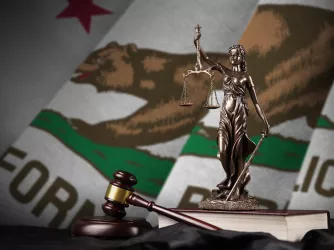Table of Contents
Damning Reply Brief Filed with Federal District Court in Hayden Barnes’ Case
Hayden Barnes' years-long battle with Valdosta State University (VSU) may be entering its final phase. Earlier this month, Barnes' attorneys filed their reply brief in support of their motion for summary judgment with District Judge Charles A. Pannell, Jr. of the United States District Court for the Northern District of Georgia, Atlanta Division.
It's been a long road for Hayden, who was expelled in 2007 for posting a collage on Facebook critical of former VSU President Ronald Zaccari's plan to construct two parking garages on campus with millions of dollars in student fees. FIRE supporters will no doubt remember the case as one of the worst abuses of a student's First Amendment rights we here at FIRE have ever seen. If you're not familiar with Hayden's epic ordeal, this short film will get you up to speed:
In the brief, Barnes' legal team—led by noted First Amendment attorney Robert Corn-Revere—make a final argument to Judge Pannell about why summary judgment should be granted to Hayden, obviating the need for a trial. The brief argues that VSU's treatment of Hayden violated his First Amendment right to freedom of expression, his due process rights, his rights under the Americans With Disabilities Act, and his contractual rights. Further, the brief argues that VSU administrators willingly and knowingly engaged in conduct that violated clearly established law of which reasonable administrators would have known—rendering them incapable of claiming qualified immunity and leaving them personally liable for damages. Judge Pannell denied the bulk of defendants' motion to dismiss Hayden's claims back in November of 2008, leaving intact Barnes' claims against the administrators in their individual capacities.
There's far more of interest in this brief than can comfortably be covered in a Torch post, but it's worth focusing more closely on two aspects of Hayden's final argument in favor of summary judgment. This post examines the brief's discussion of the violation of Hayden's First Amendment rights, and the next one will discuss why the defendants should be denied qualified immunity and found personally liable for their treatment of Hayden.
First, Corn-Revere and his fellow attorneys argue:
From the beginning, the defendants have embraced the notion that the withdrawal decision was a direct reaction to Barnes' speech. [VSU student counselor Leah] McMillan and [VSU University Attorney Laverne] Gaskins certainly do not dispute that fact, but claim only that they did not "participate" (or at least were not responsible for the decision). [Former VSU President Ronald] Zaccari, on the other hand, argues that he had every right to order Barnes' removal from campus. Either way, there is no disputing the causal connection between Barnes' speech and the withdrawal order. Zaccari does not even attempt to show that he "would have taken the same action [against Barnes] in the absence of the protected activity." Mosley, 532 F.3d at 1278 (quoting Thaddeus-X, 175 F.3d at 399). The record in this case clearly satisfies the causation element of a First Amendment retaliation claim—particularly in the university context.
Zaccari and the other VSU Defendants defend their actions on the claim that Barnes' speech was unprotected expression. However, they are wrong as a matter of law. Zaccari's claim that he was concerned about campus security and that other defendants believed his concern was genuine is irrelevant. The issue here is not what Zaccari may have felt; it is what "a reasonable person would construe . . . as a serious expression of an intention to inflict bodily harm." United States v. Callahan, 702 F.2d 964, 965 (11th Cir. 1983). To be a "true threat," the speech at issue must be "unequivocal, unconditional, immediate and specific as to the person threatened, as to convey a gravity of purpose and imminent prospect of execution." United States v. Kelner, 534 F.2d 1020, 1027 (2d Cir. 1976). The record in this case is quite clear that Barnes' political activities were not perceived as any kind of threat—much less an imminent threat—and that Zaccari's actions spoke far more loudly than his words in this respect. [Several citations removed.]
This two-part argument—that is, (1) Hayden's expulsion was a result of his speaking out against the construction of the parking garages on campus, and (2) his speech was entirely protected and did not constitute a true threat—is precisely right and identifies the source of FIRE's longstanding outrage over the actions of VSU and several of its administrators. As the brief notes, the defendants have made no attempt to pretend that Hayden's expulsion was because of anything other than his speech—after all, doing so would be an impossibly tall order, as the facts speak for themselves on this question. Crucially, the brief makes clear that Hayden's collage in no way constitutes a "true threat" and as such was protected by the First Amendment.
From the beginning, FIRE has been making this exact point—and besides, if Hayden was such a "threat," why was he expelled via a note slipped under his dorm room door? Since when is that the way to handle someone you honestly believe presents a "clear and present danger" to campus, as Zaccari claimed of Hayden? This has been a laughable contention from the start, and Hayden's brief makes that clear.
I encourage interested readers to check out the brief in full—it is compelling reading. Also, Hayden's initial motion for summary judgment is here, and his brief in opposition to the defendants' own motion for summary judgment is here. Again, see my next post on why the defendants should be denied qualified immunity and found personally liable for their treatment of Hayden.
Recent Articles
FIRE’s award-winning Newsdesk covers the free speech news you need to stay informed.

O holy fight: New Hampshire Satanic Temple statue threatened by more than vandals

California and other states are rushing to regulate AI. This is what they’re missing

One day after FIRE lawsuit, Congress passes changes to filming permits in national parks
